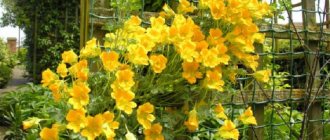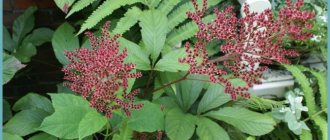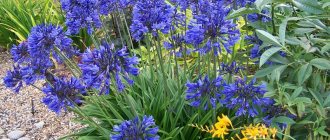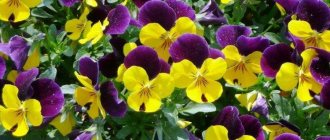Description
It is a climbing or erect, evergreen shrub of the olive family. The leaves are uniformly green in color, trifoliate or odd-pinnate in shape.
Flowers with a large corolla of regular outline, white, pale yellow or pink, with a pronounced sweet aroma. Flowering ends with the formation of an inedible berry.
The habitat today is represented by almost all the warm edges of the planet - from Africa and Australia to central America and southern Europe.
Some types of jasmine also grow in Russia, the northern Caucasus, Crimea, Kuban, Altai, and Southern Urals. Artificial cultivation is widely practiced in China.
Varieties
More than 250 varieties of this plant are known, which appeared through natural processes or created by breeders. The most famous and widespread.
Turned away. It is distinguished by bright yellow inflorescences and a strong aroma throughout the entire flowering period. Honey plant actively attracts bees and other insects. The leaves are paired, bright green.
Sambac. A liana-like variety that can grow up to 6-8 meters in length. Large leaves, and neat white inflorescences are collected in fragrant bouquets. The woody stems give a special aesthetics; landscape designers and those who like to decorate their garden plot with hedges liked all this.
Flattened. A shrub that, if properly pruned, pleases with a large number of flowers in soft pink shades and an equally refined scent that exudes all summer.
Bisa. One of the most popular decorative varieties. The vines reach a length of 2-3 meters and are strewn with umbrellas of large bright pink inflorescences with a bluish tint. If desired, you can also give it a bushy form. Combined with large, dark green leaves to create a wonderful tool for forming a living wall.
Drug. The most popular among window sill pharmacy lovers. Despite its main purpose, it has good decorative qualities. Smooth branches covered with oblong leaves and white racemose inflorescences look quite nice, and they will delight you with flowering for a long time - from April to autumn.
The thinnest. It is distinguished by “falling” shoots and large white inflorescences. The aroma, although not as pronounced as that of the above-described species, has pleasant specific notes. The leaves are dirty green, slightly pubescent at the base.
Multi-flowered. A very large, lush shrub up to two meters high, during the flowering period it is covered with an abundant “carpet” of pink and white flowers. It has the most powerful aroma of all known varieties. In addition, it is easy to recognize by its unusually shaped leaves, reminiscent of a wavy dagger.
Large-flowered. As can be understood from the name, it is distinguished by large white flowers, collected in umbrellas of 7-10 pieces. The shoots themselves can be up to ten meters long, which provides wide decorative possibilities, but imposes some pruning responsibilities.
Shrub propagation methods
Garden jasmine is propagated in several ways. The plant itself can withstand transplantation well and quickly takes root without the use of special preparations. Every gardener should know how to plant jasmine.
Propagation by seeds
Domestic and wild plants practically do not reproduce by seeds. If you propagate a flower in this way, it will bloom only after 5-7 years.
Seeds are planted in autumn or spring. In the cold season, it is necessary to cover the soil with branches or dry grass. It is generally better to do sowing in a greenhouse.
The seeds are pre-prepared and treated in Epin solution. The seedlings are mixed with sand and sent into small holes, covered with peat on top. The plant will sprout after a few weeks.
When the seedlings form their root system, they can be sent into open ground for further growth.
By cuttings
The cutting must be summer, curving and green. The length of the cutting should be 10 cm.
An even incision is made above the upper bud, and an oblique cut is made above the lower bud. The leaves from below must be removed, and the top ones must be shortened by half. The cuttings are first kept in a solution of a root formation stimulator for 20 hours.
There should be a few buds left above the soil level.
The plant is planted in a greenhouse, placed in a mixture of peat and sand. Spraying is necessary for the first 2 weeks.
Attention! In extreme heat, the greenhouse with cuttings is ventilated and protected from sunlight.
After a few weeks, the seedlings form roots and become accustomed to their environment. The young bush is transplanted into open ground in the spring.
Dividing the root system
Reproduction is rarely carried out in this way. This is due to the fact that gardeners practically do not replant adult plants, and there is no point in dividing a young bush.
If this method is nevertheless chosen, it is important to ensure that all parts have a well-developed root system.
Note! All cut areas must be treated with garden varnish to prevent infection.
Reproduction by layering
For propagation by layering, young annual shoots are used, which are located in the lower part of the plant.
In the spring, they are bent to the soil and secured with a wire bracket. Sprinkle peat-sand mixture on top. From mid-July, new shoots grow on the cuttings. They should be covered with earth before autumn.
At the beginning of October, it is necessary to pull the cuttings out of the ground and cut them off from the mother plant. The finished seedling is placed in a separate place. In winter the bush is covered.
Growing
When planting jasmine in our difficult latitudes, you need to take into account the following nuances:
- the plant is not particularly demanding on the mineral composition of the soil, but if you need an intoxicating aroma and abundant flowering, it must be fertile;
- plant either in early spring or late autumn - this is the best time for rooting;
- You should pay close attention to the behavior of groundwater and water circulation in the area as a whole, and plant only in places that are not subject to stagnant water, or neutralize them using crushed stone cushions.
The hole for planting jasmine should be about half a meter deep, and you need to add a little nitrogen-phosphorus fertilizer to it. After planting and compacting, it is necessary to water abundantly.
Comparison with mock orange and combination options
Mock orange and jasmine are unlikely to be found together. Cultures have too many differences. Evergreen jasmine grows in the southern regions, on loose soils, and loves shade and partial shade. Mock orange - cultivated in temperate latitudes, unpretentious to the composition of the soil, loves the sun.
The photo shows mock orange flowers, often called “garden jasmine”
Depending on the variety, the aroma of mock orange varies from jasmine to the unpleasantly bitter characteristic of hydrangeas. Another difference is the bark. The southern representative becomes woody when it ages, 5–6 years after planting. The mock orange immediately produces stems wrapped in brown bark. The wood of the unpretentious mock orange is hard and inactive.
The photo shows real jasmine flowers with elongated petals
The inflorescences of cultures also differ. Jasmine has straight flowers, mock orange has goblet-shaped flowers, and many varieties have semi-double and double flowers. Jasmine varieties cannot boast of such splendor.
Features at home
If you plan to use jasmine as an indoor flower, then it should be placed in spacious rooms. A powerful aroma is wonderful in an open garden, but in a confined space its abundance can have a detrimental effect on well-being.
The plant itself can suffer from the wrong location and tap water. Sun rays refracted through double-glazed windows can burn delicate foliage, causing it to yellow and die.
Butterflies: beautiful creatures from the world of insectsHow to grow excellent petunia seedlings
- How to properly water an orchid in a pot: the benefits of automatic watering for the plant
The same goes for hard tap water. To avoid these troubles, you need to use a softening filter and choose a place without excessive sunlight.
If these conditions are met, but your bush still does not want to bloom, most likely there were errors during planting in the form of too deep grounding. The solution is to replant so that the rhizome sticks out of the ground a little. The cause may also be insufficient soil acidity, which can be solved with appropriate fertilizers.
Caring for indoor jasmine
Such an amazing and beautiful culture can grow on the windowsill of an apartment or private house. The flower pot is placed only on an east or west window so that the plant has a constant stream of sunlight.
In the warm season, the pot is taken out into the fresh air (this can be a balcony or summer terrace). It is important to ensure that there are no drafts or direct sunlight in this area (risk of leaf burns).
Indoor plants must be constantly sprayed to maintain high air humidity. Only settled water at room temperature is used for this purpose. Stop spraying during the period of active flowering of the bush.
Caring for jasmine (indoors or intended for open ground) is not particularly difficult. Even inexperienced gardeners can cope with the tasks. Following a number of simple rules will allow you to admire the snow-white cloud of bright inflorescences throughout the season and even drink very healthy, delicious tea.
Application
Who hasn’t drunk green tea with jasmine flowers, the properties of which give the drink a unique range of smells? This combination is so loved by consumers that today it can be found in any store. It is also used as a flavoring agent for confectionery products, alcoholic beverages and other food products.
It is curious that photos of jasmine flowers on tea boxes are sometimes images of mock orange. These plants are often confused due to their similar aroma and appearance.
In addition to its decorative and gastronomic value, some of the properties of this universal plant have found application in folk medicine and medical cosmetology.
Useful information about the plant
The aroma of jasmine helps get rid of annoying insects in summer. If you plant several varieties of plants around the house, they will bloom alternately. Bushes look good in landscape design against a background of lilacs. The jasmine type of this representative of the flora is recommended to be planted near gazebos or next to artificial reservoirs.
Any gardener who knows what jasmine is can plant it on his plot. If you follow all the recommendations of experts on caring for this plant, you have a chance to decorate your area with a fragrant and useful bush.
0 0 votes
Article rating
Healing properties
The benefits of jasmine flowers are due to the high content of many essential acids and essential oils. Leaves and flowers, due to the presence of salicyl-containing elements in them, have mild antiseptic properties sufficient to disinfect cuts.
Essential oils and flower decoctions are widely used as a tonic that has a beneficial effect on all organ systems, especially the nervous one.
There is also a positive effect on the female body during lactation and menstruation. Medicines for insomnia and migraines are prepared from the roots.
People with hypertension and stomach ulcers, as well as allergy sufferers, should be careful when using jasmine.
Landing
Young plants should be replanted annually, but adult plants can be replanted less frequently - once every 3 years is enough. Initially, you will need to prepare the soil. To do this, take sand, deciduous soil and a clay-leaf soil mixture in a 1: 1 ratio. If you need to transplant the crop into a larger pot, then the composition of the soil will be slightly different - you should take 2 times more clay-leaf soil mixture.
It is better to change the pot when the flower begins to fade. The root collar should be located at ground level during transplantation, so the plant will feel good. After planting or transplanting, it is forbidden to place the plant in a pot under direct UV rays. It is necessary to provide the crop with regular watering, as well as spraying with soft water.











